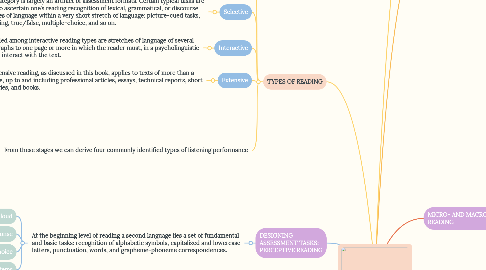
1. TYPES OF READING
1.1. Perceptive
1.1.1. In keeping with the set of categories specified for listening comprehension, similar specifications are offered here, except with some differing terminology to capture the uniqueness of reading.
1.2. Selective
1.2.1. This category is largely an artifact of assessment formats. Certain typical tasks are used to ascertain one’s reading recognition of lexical, grammatical, or discourse features of language within a very short stretch of language: picture-cued tasks, matching, true/false, multiple-choice, and so on.
1.3. Interactive
1.3.1. Included among interactive reading types are stretches of language of several paragraphs to one page or more in which the reader must, in a psycholinguistic sense, interact with the text.
1.4. Extensive
1.4.1. Extensive reading, as discussed in this book, applies to texts of more than a page, up to and including professional articles, essays, technical reports, short stories, and books.
1.5. From these stages we can derive four commonly identified types of listening performance
1.5.1. 1. Intensive. Listening for perception of the components (phonemes, words, intonation, discourse markers, etc.) of a larger stretch of language.
1.5.2. 2. Responsive Listening to a relatively short stretch oflanguage (a greeting, question, command, comprehension check, etc.) in order to make an equally short response
1.5.3. 3. Selective Processing stretches of discourse such as short monologues for several minutes in order to "scan" for certain information
1.5.4. 4. Extensive Listening to develop a top-down, global understanding of spoken language.
2. DESIGNING ASSESSMENT TASKS: PERCEPTIVE READING
2.1. At the beginning level of reading a second language lies a set of fundamental and basic tasks: recognition of alphabetic symbols, capitalized and lowercase letters, punctuation, words, and grapheme-phoneme correspondences.
2.1.1. Reading Aloud
2.1.2. Written Response
2.1.3. Multiple-Choice
2.1.4. Picture-Cued Items
3. DESIGNING ASSESSMENT TASKS: SELECTIVE READING
3.1. Just above the rudimentary skill of perception of letters and words is a category in which the test designer focuses on formal aspects of language
3.1.1. Multiple-Choice (for Form-Focused Criteria)
3.1.2. Matching Tasks
3.1.3. Editing Tasks
3.1.4. Picture-Cued Tasks
3.1.5. Gap-Filling
4. DESIGNING ASSESSMENT TASKS: INTERACTIVE READING
4.1. Cloze Tasks
4.2. Impromptu Reading Plus Comprehension Questions
4.3. Short-Answer Tasks
4.4. Editing (Longer Texts)
4.5. Scanning
4.6. Sequencing
4.7. Information Transfer: Reading Charts, Maps, Graphs, Diagrams
5. DESIGNING ASSESSMENT TASKS: EXTENSIVE READING
5.1. Extensive reading involves somewhat longer texts than we have been dealing with up to this point. Journal articles, technical reports, longer essays, short stories, and books fall into this category.
5.1.1. Skimming Tasks
5.1.2. Sumarizing and Responding
5.1.3. Notetaking and Outlining
6. WHAT IS ASSESING READING
6.1. In foreign language learning, reading is likewise a skill that teachers simply expect learners to acquire.
7. GENRES OF READING
7.1. Each genre of written text has its own set of governing rules and conventions.
7.1.1. 1. Academic reading General interest articles (in magazines, newspapers, etc.) Technical reports (e.g., lab reports), professional journal articles Reference material (dictionaries, online encyclopedias, etc.) Textbooks, theses Essays, papers Test directions Editorials and opinion writing
7.1.2. 2. Job-related reading Messages (e.g., phone messages) Letters/e-mails Memos (e.g., interoffice)
7.1.3. 3. Personal reading Newspapers and magazines E-mails, greeting cards, invitations Messages, texts, notes, lists, blogs
7.1.4. 4. In most cases (except for repetition tasks, which involve short-term memory only), you delete the exact linguistic form in which the message was originally received in favor of conceptually retaining important or relevant information in long-term memory.
8. MICRO- AND MACROSKII.lS OF READING
8.1. Aside from attending to genres of text, the skills and strategies fot accomplishing reading emerge as a crucial consideration in the assessment of reading ability.
8.1.1. MICROSKILLS
8.1.2. 1. Discriminate among the distinctive graphemes (letters or letter combinations that produce a phoneme) and orthographic patterns of English
8.1.3. 2. Retain chunks of language of different lengths in short-term memory
8.1.4. 3. Process writing at an efficient rate of speed to suit the purpose
8.1.5. 4. Recognize a core of words and interpret word order patterns and their significance
8.1.6. 5. Recognize grammatical word classes (nouns, verbs, etc.), systems (e.g., tense, agreement, pluralization), patterns, rules, and elliptical forms
8.1.7. 6. Recognize that a particular meaning may be expressed in different grammatical forms .
8.1.8. 7. Recognize cohesive devices in written discourse and their role in signaling the relations between and among clauses
8.1.9. MACROSKILLS
8.1.9.1. 8. Recognize the rhetorical conventions of written discourse and their significance for interpretation
8.1.9.2. 9. Recognize the communicative functions of written texts, according to form and purpose
8.1.9.3. 10. Infer context that is not explicit by activating schemata (using background knowledge)
8.1.9.4. 11. From described events, ideas, and so on, infer links and connections between events, deduce causes and effects, and detect such relations as main idea, supporting idea, new information, given information, generalization, and exemplification
8.1.9.5. 12. Distinguish between literal and implied meanings
8.1.9.6. 13. Detect culturally specific references and interpret them in a context of the appropriate cultural schemata
8.1.9.7. 14. Develop and use a battery of reading strategies, such as scanning and skimming, detecting discourse markers, guessing the meaning of words from context, and activating schemata to interpret texts
